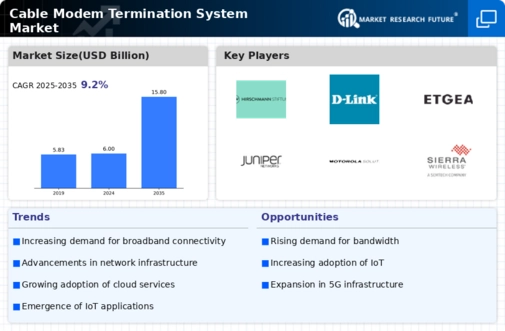The Cable Modem Termination System (CMTS) market is currently characterized by a dynamic competitive landscape, driven by the increasing demand for high-speed internet and the proliferation of digital services. Key players such as Cisco Systems (US), Arris International (US), and Harmonic (US) are strategically positioned to leverage their technological expertise and extensive product portfolios. Cisco Systems (US) focuses on innovation and digital transformation, emphasizing the integration of advanced software solutions into their hardware offerings. Meanwhile, Arris International (US) has been actively pursuing partnerships to enhance its service delivery capabilities, thereby strengthening its market presence. Harmonic (US), on the other hand, is concentrating on cloud-based solutions, which aligns with the growing trend towards virtualization in network management. Collectively, these strategies contribute to a competitive environment that is increasingly centered around technological advancement and service differentiation.
In terms of business tactics, companies are localizing manufacturing and optimizing supply chains to enhance operational efficiency and reduce costs. The CMTS market appears moderately fragmented, with several key players exerting influence over various regional markets. This fragmentation allows for a diverse range of offerings, catering to different customer needs and preferences. The collective influence of these major players shapes the market structure, fostering an environment where innovation and customer-centric solutions are paramount.
In August 2025, Cisco Systems (US) announced a strategic partnership with a leading telecommunications provider to enhance its CMTS offerings. This collaboration aims to integrate next-generation software-defined networking capabilities, which is expected to significantly improve network performance and scalability. The strategic importance of this partnership lies in its potential to position Cisco as a leader in the rapidly evolving landscape of digital services, thereby enhancing its competitive edge.
In September 2025, Arris International (US) launched a new line of CMTS products designed specifically for small to medium-sized service providers. This product line aims to address the unique challenges faced by these providers, such as cost constraints and the need for flexible deployment options. The introduction of this tailored solution underscores Arris's commitment to expanding its market reach and catering to underserved segments, which could lead to increased market share.
In October 2025, Harmonic (US) unveiled a cloud-native CMTS solution that leverages artificial intelligence to optimize network performance. This innovative approach not only enhances operational efficiency but also aligns with the industry's shift towards AI integration. The strategic significance of this development is profound, as it positions Harmonic at the forefront of technological advancement in the CMTS market, potentially attracting new customers seeking cutting-edge solutions.
As of October 2025, the competitive trends in the CMTS market are increasingly defined by digitalization, sustainability, and the integration of artificial intelligence. Strategic alliances among key players are shaping the landscape, fostering innovation and collaboration. Looking ahead, it is likely that competitive differentiation will evolve, with a pronounced shift from price-based competition to a focus on innovation, technology, and supply chain reliability. This evolution suggests that companies that prioritize these aspects will be better positioned to thrive in the future.
















Leave a Comment